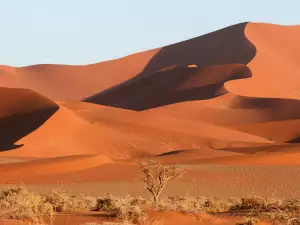Three extraterrestrial destinations worldwide
MadagascarThe isolation of Madagascar for a period of about 150 million years has played a huge role in the geological diversity of the island. It is home to plants, insects, reptiles and mammals that fascinate us with their unusual appearance.
Compared to any other destination, Madagascar looks like the landscape of another planet. About 80% of the plants here are not found elsewhere and a large number of species are endemic. The stars of the animal world are undoubtedly Madagascar lemurs; these include small mouse lemurs and Madagascar raccoons.
In Madagascar they live in total about 105 endemic species, many chameleons and countless butterflies and unusual insects. On the island state there are extended tropical rain forests, tropical dry forests, plateaus, desert and semi desert. These varied from an environmental perspective, regions and wildlife, which occurs in them are the reason some scientists call Madagascar “the eighth continent”.
Malagaches like their food simply prepared, flavorful, but as we have said, not highly spiced. Fruits and vegetables are utilized at their freshest, and it is not uncommon to start a meal with vegetable soup and then to serve two or three vegetables with the entree. The beverage that goes with the meal is Ranonapango, a drink made by burning rice--yes, actually burning the rice and adding water to it.
Socotra
This terrestrial landscape is inhabited by strange birds and animals, strange trees and prehistoric sites. This unique terrestrial area was formed over the period of the Neozoic Miocene era, when the four island archipelago of the same name separated from the Gondwana continent. Socotra thus, the largest island of the archipelago became one of the most isolated territories which begin to develop its own rhythm, different from the rest of the world.
The trees on the island contrary to scripture in the textbooks of botany, animals do not quite resemble the inhabitants of the area, located in such proximity to Africa, and people are different, they are neither Africans nor Arabs nor Europeans
Of about 800 plant species found on the island, 24 are endemic species, and every year biologists find new species. Signs of the dracaena tree are a curious form what is known from ancient times because of the red juice, which separates. Dratsena vermilion-red, beautiful Rose of the desert and dorsteniyata are all part of the alien flora of Socotra. Dorsteniyata is a plant that does not require any soil to grow, but does require rock. Fauna of the island is no less unique. 80% of reptiles are endemic. Giant centipedes, bizarre insects, and over 20 species of spiders, are those which may attract tourists. They are of great importance for entomologizing. Six of these 140 some are species of birds on the island are found only here, but the only representative of mammals are bats.
Namib Desert

The landscape may seem weird, but plants and animals that have managed to adapt to the harsh conditions of life are no less impressive. Most tourists choose this surreal trip to see the famous dunes. These are the highest dunes in the world, reaching a height of 300 meters and are shaped in razor sharp ridges by the winds of the desert. It is believed that one of the most exciting experiences was a balloon flying over the dunes.
